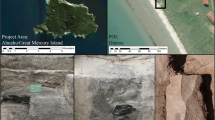Abstract
This paper aims to conduct a detailed investigation of the archaeological record, bringing together spatial, contextual, artifactual, and ecofactual data in different scales of recovery conditions. An extra attempt was made not only to integrate zooarchaeological and archaeobotanical but also artifactual data. This approach aimed to see the complete picture of the archaeological record, where environmental data were considered as important as artifacts and would contribute to a comprehensive interpretation of the archaeological record.
A workshop/domestic building complex from the Byzantine site of Komana has been used to illustrate an efficient merge of these different categories of data. In particular, one room was given a special attention and investigated in detail.
The fill of the room contains numerous highly fragmented sherds of coarse storage vessels, burnt cooking pots, and glazed fine wares. A large number of animal bone remains have also been recovered. Furthermore, a considerable number of plant remains, originating from burnt layers, ovens, and pits, have been recovered.
Access this chapter
Tax calculation will be finalised at checkout
Purchases are for personal use only
Similar content being viewed by others
References
Bermejo, J., & Quevedo, A. (2014). The fortuna domus (Cartagena, Spain): An archaeological analysis of household activities in a Hispano-Roman Colonia. European Journal of Archaeology, 17(3), 487–516.
Erciyas, D. B. (2014) Komana’da (Sisiyye) 2010-2012 Yılları Kazı Çalışmaları. 35. Kazı Sonuçları Toplantısı 1.Cilt, 281–291.
Erciyas, D. B., ve Tatbul, M. N. (2015). Komana Ortaçağ Yerleşimi / The Medieval Settlement at Komana. Yerleşim Arkeolojisi Serisi 5, Monografi 1, Ege Yayınları, İstanbul.
Erciyas, D. B., Tatbul, M. N., Sökmen, E., Kocabıyık, C., & Sünnetçi, R. (2015). Komana’da 2009-2014 Yılları Arasında Yapılan Kazı Çalışmalarının Ön Değerlendirmesi. In D. B. Erciyas & M. N. Tatbul (Eds.), Komana Ortaçağ Yerleşimi/The Medieval Settlement at Komana, Yerleşim Arkeolojisi Serisi 5, Monografi 1 (pp. 21–61). İstanbul: Ege Yayınları.
Erciyas, D. B., Sökmen, E., ve Kocabıyık, C. (2011). Komana Antik Kenti 2009 Yılı Kazı Çalışmaları 32. Kazı Sonuçları Toplantısı 4.Cilt, 121–133.
Erciyas, D. B., ve Tatbul, M. N. (2016). Anadolu’da Ortaçağ Kazıları ve Komana, 37.Kazı Sonuçları Toplantısı, 611–626, Erzurum.
Erciyas, B., & Tatbul, M. (2017). The Roman Period at Komana. In M. Manoledakis (Ed.), The Black Sea in the Light of New Archaeological Data and Theoretical Approaches, Proceedings of the 2nd International Workshop on the Black Sea in Antiquity, 18-20 September 2015, International Hellenic University (pp. 239–250). Thessaloniki: Archaeopress Publishing, Oxford.
Gallagher, D. E. (2014). Formation processes of the macrobotanical record. In J. M. Marston, C. Warinner, & J. d’Alpoim Guedes (Eds.), Method and theory in paleoethnobotany (pp. 19–34). Boulder: University Press of Colorado.
Hardin, J. W. (2004). Understanding Domestic Space: An Example from Iron Age Tel Halif. Near Eastern Archaeology, 67(2), 71–83.
Marston, J. M., Warinner, C., & d’Alpoim Guedes, J. (2014). Paleoethnobotanical Method and Theory in the Twenty-First Century. In J. M. Marston, C. Warinner, & J. d’Alpoim Guedes (Eds.), Method and theory in paleoethnobotany (pp. 1–18). Boulder: University Press of Colorado.
Pişkin, E., & Tatbul, M. N. (2015). Archaeobotany at Komana: Byzantine plant use at a rural cornucopia. In D. B. Erciyas, ve M. N. Tatbul (Eds.), Komana Ortaçağ Yerleşimi/The Medieval Settlement at Komana (Yerleşim Arkeolojisi Serisi 5). İstanbul: Monografi 1/Ege Yayınları.
Putzeys, T. (2007). Contextual analysis at sagalassos: Develo** a methodology for classical archaeology, Katholieke Universiteit Leuven, PhD Dissertation.
Schiffer, B. M. (1972). Archaeological context and systemic context. American Antiquity, 37(2), 156–165.
Schiffer, B. M. (1996). Formation processes of the archaeological record. Salt Lake City: University of Utah Press.
Smith, D. N. (2013). Defining an indicator package to allow identification of ‘cesspits’ in the archaeological record. Journal of Archaeological Science, 40, 526–543.
Tatbul, M. N. (2013). Understanding the function of an 11th century AD medieval building complex at komana through the spatial analysis of archaeological data: A pilot study. In M. Manoledakis (Ed.), Exploring the hospitable sea, proceedings of the International Workshop on the Black Sea in Antiquity held in Thessaloniki, 21-23 September 2012, BAR international series (Vol. 2498, p. 2013). Oxford, England: Archaepress.
Tatbul, M. (2017). Identifying Medieval Komana in the 12th–13th Centuries Through Spatial Analysis of Archaeological Data with a Multidisciplinary Approach, Middle East Technical University, Department of Settlement Archaeology, Unpublished PhD Dissertation.
Twiss, K. C., Bogaard, A., Charles, M., Henecke, J., Russell, N., Martin, L., & Jones, G. (2009). Plants and animals together: Interpreting organic remains from building 52 at Çatalhöyük. Current Anthropology, 50(6), 885–895.
Van Derwarker, A. M. (2010). Simple measures for integrating plant and animal remains. In A. M. Van Derwarker & T. M. Peres (Eds.), Integrating zooarchaeology and paleoethnobotany: A consideration of issues, methods, and cases (pp. 65–74). New York: Springer.
Author information
Authors and Affiliations
Corresponding author
Editor information
Editors and Affiliations
Rights and permissions
Copyright information
© 2018 Springer International Publishing AG, part of Springer Nature
About this chapter
Cite this chapter
Tatbul, M.N. (2018). All or Nothing: Spatial Analysis and Interpretation of Archaeological Record Based on the Integration of Artifactual, Ecofactual, and Contextual Data at the Medieval Site of Komana. In: Pişkin, E., Marciniak, A., Bartkowiak, M. (eds) Environmental Archaeology. Interdisciplinary Contributions to Archaeology. Springer, Cham. https://doi.org/10.1007/978-3-319-75082-8_11
Download citation
DOI: https://doi.org/10.1007/978-3-319-75082-8_11
Published:
Publisher Name: Springer, Cham
Print ISBN: 978-3-319-75081-1
Online ISBN: 978-3-319-75082-8
eBook Packages: Social SciencesSocial Sciences (R0)




